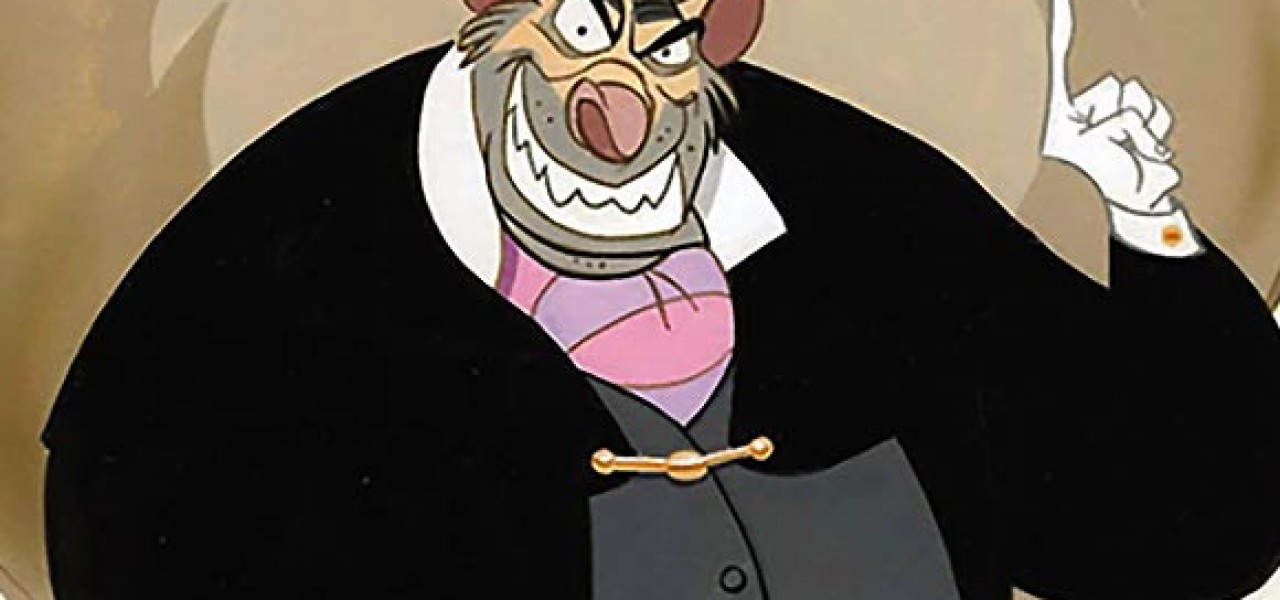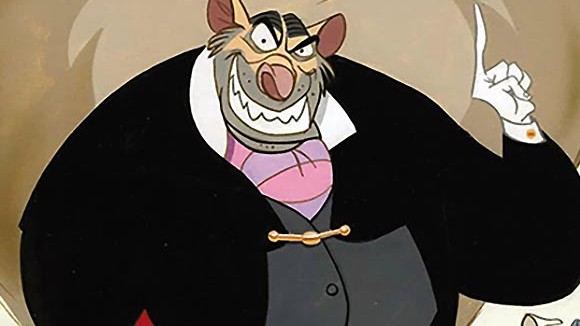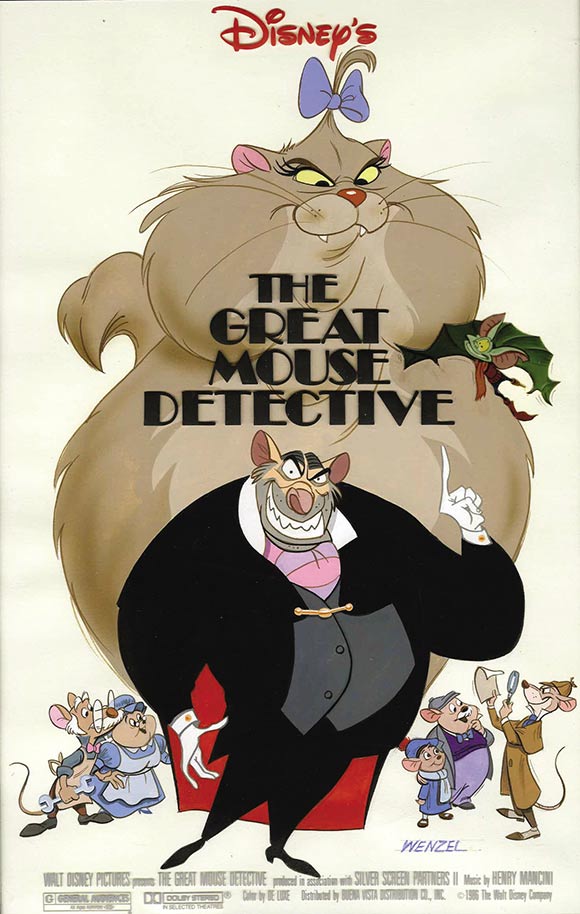

‘Mouse in Transition’: Basil or Mouse Detective? (Chapter 19)

This is the final chapter of Mouse in Transition. It is the story of Disney Feature Animation—from the Nine Old Men to the coming of Jeffrey Katzenberg. Ten lost years of Walt Disney Production’s animation studio, through the eyes of a green animation writer.
Steve Hulett spent a decade in Disney Feature Animation’s story department writing animated features. Since 1989, he has served as the business representative of the Animation Guild, Local 839 IATSE, a labor organization which represents Los Angeles-based animation artists, writers and technicians. Read every chapter of his story:
Chapter 1: Disney’s Newest Hire
Chapter 2: Larry Clemmons
Chapter 3: The Disney Animation Story Crew
Chapter 4: And Then There Was…Ken!
Chapter 5: The Marathon Meetings of Woolie Reitherman
Chapter 6: Detour into Disney History
Chapter 7: When Everyone Left Disney
Chapter 8: Mickey Rooney, Pearl Bailey and Kurt Russell
Chapter 9: The CalArts Brigade Arrives
Chapter 10: Cauldron of Confusion
Chapter 11: Rodent Detectives and Studio Strikes
Chapter 12: Disney Dead-Ends & Lucrative Mexican Caterpillars
Chapter 13: Basil Kicks Into High Gear
Chapter 14: “Call Us Mike and Frank”
Chapter 15: The Arrival of Jeffrey Katzenberg
Chapter 16: A Gong Show with Eisner and Katzenberg
Chapter 17: The Trials of Oliver & Company
Chapter 18: Goodbye Disney
For the next few months I sat home licking my wounds and writing a novel that didn’t sell. I still heard from people at the studio. Several told me that upper management had changed the title of Basil of Baker Street to The Great Mouse Detective, a title that many animation employees—and especially the story crew—hated. Management, however, was skittish about anything referencing Sherlock Holmes, since Young Sherlock Holmes from producer Steven Spielberg had flopped.
But all the bitching about the new title prompted the puckish story artist Ed Gombert to spring back into action with another of his phony studio memos. His latest went like this:
To: Animation Department
From: Peter Schneider
Along with the new title for Basil of Baker Street it has been decided to rename the entire library of animated classics. The new titles are as follows…
SEVEN LITTLE MEN HELP A GIRL
THE WOODEN BOY WHO BECAME REAL
COLOR AND MUSIC
THE WONDERFUL ELEPHANT WHO COULD REALLY FLY
THE LITTLE DEER WHO GREW UP
THE GIRL WITH THE SEE-THROUGH SHOES
THE GIRL IN THE IMAGINARY WORLD
THE AMAZING FLYING CHILDREN
TWO DOGS FALL IN LOVE
THE GIRL WHO SEEMED TO DIE
PUPPIES TAKEN AWAY
THE BOY WHO WOULD BE KING
A BOY, A BEAR AND A BIG BLACK CAT ARISTOCATS
ROBIN HOOD WITH ANIMALS
TWO MICE SAVE A GIRL
A FOX AND A HOUND ARE FRIENDS
THE EVIL BONEHEADAnd of course our latest classic destined to win the hearts of the American public…
THE GREAT MOUSE DETECTIVE

After Ed composed the memo, he passed his creation around to a chosen few. They found it hilarious. So hilarious, in fact, that one of them, inspired by his puckish wit, sent it on to Jeffrey Katzenberg.
Apparently, Jeffrey wasn’t amused. He phoned Peter Schneider and asked, “What is going on? What are your people DOING?!”
Peter, in fact, didn’t have any idea what they were up to…until Jeffrey showed him a copy of the memo from an unknown writer. Peter’s name was on top of it:
OUTRAGE!
A department-wide meeting was hurriedly called, with Peter voicing his displeasure at a volume near the threshold of pain. Animator Steve Gordon remembered:
“Boy, was Schneider livid! He let loose a string of expletives and the entire audience gasped. I think it was probably the first time many of the Disney personnel were introduced to true ‘Hollywoodese’ in such a public forum. Several of the artists that had never worked anywhere but at Disney looked as if they had taken a wrong turn and stepped into Hell.”
Another artist told me: “The veins on Peter’s neck REALLY stood out.”
Ed Hansen, the Disney production executive with years of employee shenanigans under his belt, tried to calm Mr. Schneider down, saying to him, “These are animators, Peter. Jokes and pranks are what animators do.”
Mr. Schneider was not calmed.
Soon after the blowup, my wife brought home a copy of Mr. Gombert’s memo. Still smarting from my layoff, I made a quick decision to send a copy of it to the LA Times, along with a detailed (and anonymous) explanation of what it was. The Mrs. argued vehemently that I should mind my own business, but I ignored her. I popped letter and memo into the nearest post box, and waited.
Four days later, a long story about the cheeky memo showed up in the Times’ entertainment section:
Mousechievious Memo Upsets Big Cheese
A mystery’s afoot in the animation department at Disney, and it’s going to take a moustermind to solve it.
What we shall call “The Case of the Impertinent Memo” began when Disney’s marketing department invited the animation department to suggest new titles for Basil of Baker Street, an animated feature about a famous crime-fighting mouse.
According to a little bird, the brass decided that the title might suffer from the same problem that sank Steven Spielberg’s Young Sherlock Holmes: “Too British” for American kids.
But marketing eschewed the animators’ suggestions and renamed it The Great Mouse Detective. It opens under that title Wednesday.
The animators think the title is as imaginative as retitling Snow White and the Seven Dwarfs as Seven Little Men Help a Girl. In fact, one day in February, a memo appeared on the animation department bulletin board announcing that the studio had renamed all of its animated classics. First on the list was Seven Little Men Help a Girl.
The memo provoked merriment among the artists, the little bird told us, but the department chief wasn’t as amused. His named appeared on the memo and he was invited by management to explain.
Robert Levin, head of Disney marketing, confirmed this scenario and suggested that management might have been a little more sensitive to the animators.
“Basil was a film they had been working on for a long period of time,” Levin said. “For us to come in late in the process and say ‘We want to change this thing you’ve been working on’ was difficult to take. We have all agreed that on future releases, we’ll work closer together earlier.”
Meantime, the author of the [memo] is still at large.
Thanks to the LA Times piece, Mr. Gombert’s handiwork enjoyed a long shelf-life. Years after its creation, the titles on it triggered a series of questions on a Jeopardy episode. Good practical jokes never die.
But the mouse wasn’t quite done with me yet. The company mailed me a plaque for my ten years of faithful service, even though I fell several months short, and I hung it in the small closet I used for an office. (When you’re feeling bad about being let go, it’s always nice to put up reminders.) Then they mailed me an invitation to the Great Mouse Detective wrap party. It was held on the studio lot, and I attended in coat and tie, feeling like a sailor bobbing in the ocean as his battleship steams away.

Money was running low, my wife was getting edgy, and I knew that I needed to find some way to make a living—and fast. I tromped around to every animation studio I could think of, showing story editors my resume and work samples. The response was under-whelming:
“Writing features at Disney is fine and good, Mr. Hulett, but TV work is different. We don’t spend two years on a project. We need a script turned out every couple of weeks. We’re not sure you can DO this.”
I was going nowhere at a brisk trot, and I couldn’t see so much as a low-watt flashlight at the end of the tunnel. Because cash flow was imperative, and there were no writing jobs that were getting me any, I went out and got an emergency teaching credential. A few months before I had been creating family entertainment at Walt Disney Productions. Now I was instructing (baby-sitting?) kindergarteners, third-graders, high school students, and every age bracket in-between.
The Great Mouse Detective cycled through its theatrical run and moved on to video. I got a job teaching at a private school making a princely $350 per week. If anyone was through with the cartoon business, it was me. I had no time for writing spec scripts or traipsing to job interviews at Hanna-Barbera. My future was standing in front of distracted high school students, yapping about spelling and sentence construction. And grading essays on Julius Caesar.
And then I got another invitation from Disney. The Great Mouse Detective had been nominated for an Edgar by the Mystery Writers of America. Since I had penned a lot of the script, a staffer at Disney Feature sent me an invitation to the awards banquet being held in the Blossom Room of the Hollywood Roosevelt Hotel, an iconic landmark on Hollywood Boulevard that had once been state-of-the-art, but was now a sixty-year-old stone and mortar monument to the good old days.
The Blossom Room turned out to be a long, narrow space filled with linen-covered tables. It had hosted the first Academy Awards in 1929, but there were no movie stars in view for the mystery writers awards, just a lot of tweedy-looking book authors and most of The Great Mouse Detective story crew.
I hadn’t seen any of my former colleagues in a year, and asked how their workdays at the studio were going. Burny Mattinson said he was doing storyboard work. John Musker mentioned that he and Ron Clements were deep into development on The Little Mermaid, and nervous about their script getting greenlit for production. Bruce Morris told me he was now a studio executive, but ambivalent about the new position, since he liked doing hands-on story work.
Burny asked what I was up to. I hemmed and hawed and finally said, “Writing a book…and teaching in a private school.” Half of that was a lie. Prepping classwork, teaching, and grading papers took up all my waking hours. I had no time to write anything more complicated than a grocery list, but I was loath to admit it. My former co-workers were making movies while I was standing in front of a white board, ducking spit balls.
Mouse Detective’s award category was “Best Motion Picture of 1987.” I didn’t kid myself it was the odds-on favorite, since its competition was Something Wild, Defense of the Realm, F/X, Manhunter, and The Name of the Rose. But hope is a hard emotion to kill, and I sat on the front of my chair thinking positive thoughts.
The ceremony ground on. Statuettes were given out for Best Mystery Novel, then Best Mystery Short Story. When our category finally came up, the nominees were rattled off, and the envelope opened. To nobody’s surprise, the winner turned out to be the Jeff Daniels/Melanie Griffith movie Something Wild, but we still sagged in our chairs a little. It’s always nice to win a trophy, even if it’s the head of Edgar Allan Poe.
Burny seemed to take The Great Mouse Detective’s loss a bit harder than the rest of us, only natural since he was the producer of the film. As the final trophy was handed out and the master of ceremonies bid the crowd good night, I shook Burny’s hand and told him I was sorry he hadn’t walked away with the prize.
“Well, we got nominated, at least,” he sighed. “You going to stay in animation?”
By this time we were walking to the hotel’s rear exit. I wagged my head, and said, “Probably not.”
“You know, I’ve brought your name up in production meetings. To be a writer in the department again. But…” His voice trailed off.
“I doubt Peter Schneider or Roy [E. Disney] or Jeffrey Katzenberg is interested in me coming back ever,” I said. “I’m yesterday’s news.”
Burny shrugged, wished me good night, and moved off to get his car. And I stood in a mill of mystery writers, thinking, “So that’s it. Ten years in animation and out. I’ll probably be teaching high school English until I retire.”
My prediction turned out to be completely wrong. But then, when it comes to guessing where my career might be going, I’ve never had much of a clue.
Mouse in Transition has been released in paperback and e-book formats from Theme Park Press. In addition to Hulett’s on-going narrative, the book contains a foreword by Disney director John Musker, a half-dozen interviews with Disney old-timers, and biographical sketches of Disney animation staffers who worked at the studio in the 1970s and ’80s.

.png)